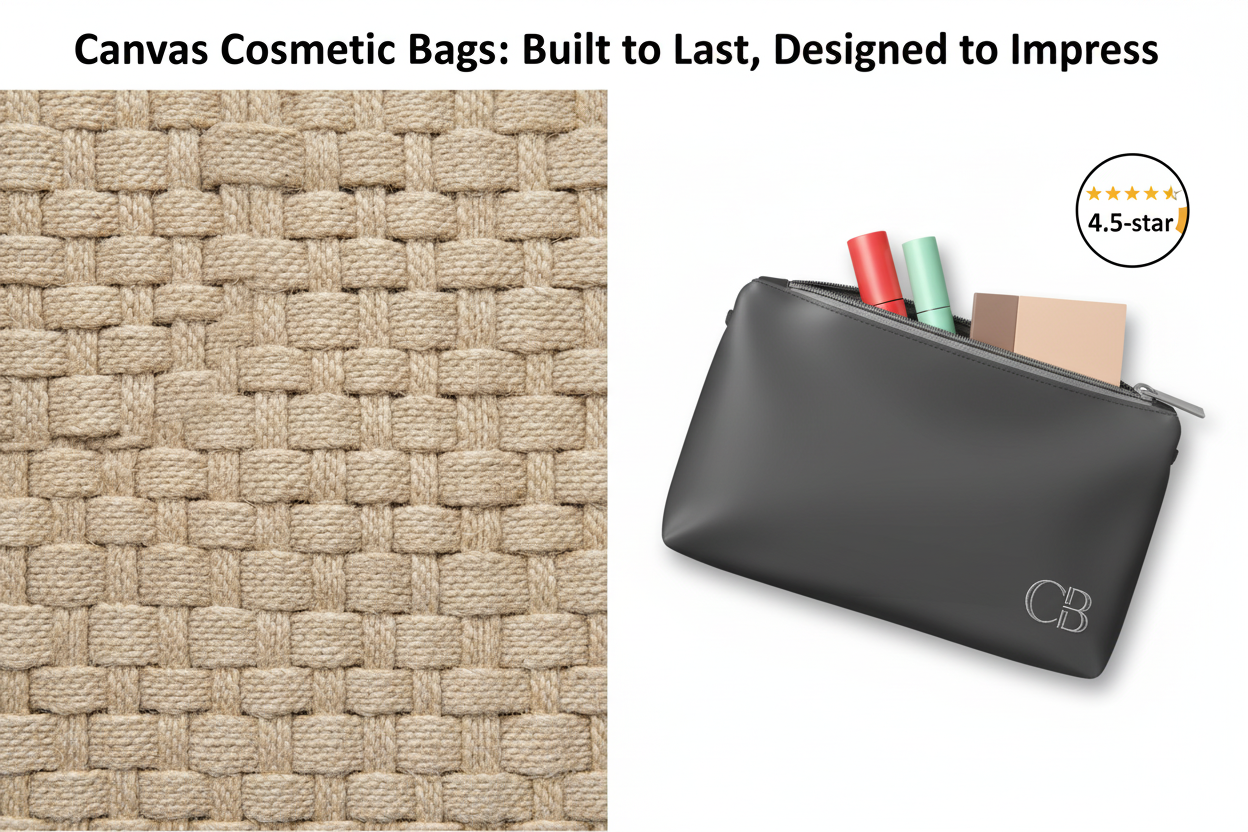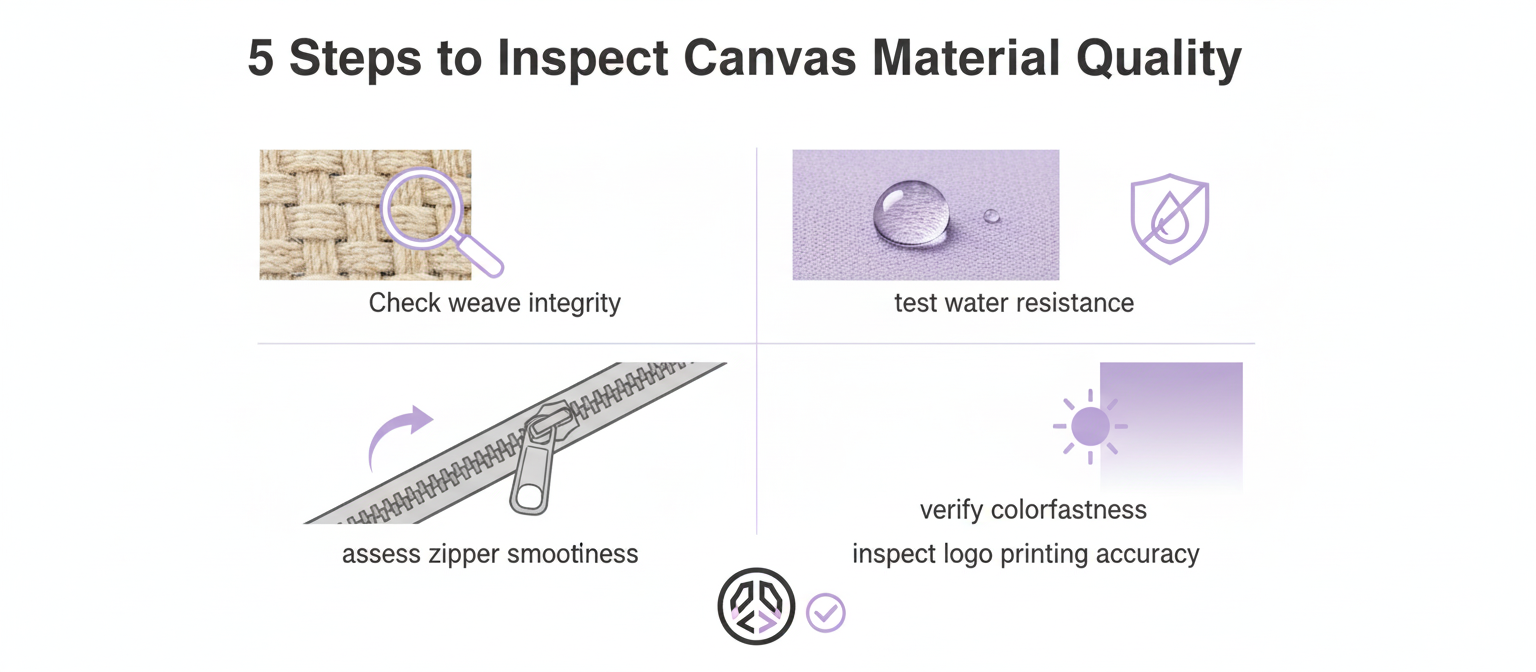What Is Canvas Material Made Of?

Ever tugged at the zipper of a cosmetic bag only to have the whole thing cave like a soggy taco? That’s what happens when brands cut corners on materials. The smarter ones are turning to canvas material—a fabric that’s got grit, charm, and staying power. Natural versions (usually cotton or linen) feel earthy and honest, while the synthetic blends (often polyester) bring in extra muscle for water resistance and everyday wear. It’s not just fabric—it’s your brand’s handshake.
Smart buyers know: looks matter, but longevity seals the deal. When you’re ordering thousands of custom bags for retail shelves or promo giveaways, you want something that holds up in a makeup artist’s kit and flaunts your logo without flaking out after two washes. Canvas does both—like it was born to hustle.
Canvas Material Chronicles: Key Points for Cosmetic Bag Buyers
Durability That Delivers: Canvas material—especially in tightly woven forms—is built to endure the daily demands of beauty professionals and frequent travelers alike.
Natural vs. Synthetic Trade-Offs: Natural canvas offers an eco-conscious, textured charm, while synthetic blends step up with water resistance and lighter weight.
Water-Resistant Lining Matters: When paired with canvas, a moisture-repelling interior keeps cosmetics safe from spills and external dampness.
Customization is Brand Currency: Personalized logo printing on canvas bags boosts brand identity across retail shelves or promotional campaigns.
Quality Check Essentials: Before bulk orders, inspect weave consistency, zipper glide performance, and color retention—especially in softer tones like pastel lavender.
Why Choose Canvas For Cosmetic Bags
Canvas cosmetic bags have become the go-to for beauty pros and brands. Here’s why they’re stealing the spotlight in both studios and stores.
Durable canvas material for professional makeup artists
- Built tough with high thread count to handle heavy use
- Reinforced stitching resists tearing even under pressure
- Made from natural fibers like cotton, linen, or hemp—earth-friendly and long-lasting
• Beauty artists love how it holds shape, even when packed to the brim
• It’s not just strong—it breathes, so brushes stay fresh longer
You’ll also find that many pro-grade bags use tightly woven duck canvas, which adds structure without bulk. That kind of durability is no accident—it’s engineered through smart choices in weave density and fabric weight. Topfeel’s pro kits are a prime example, offering peak performance in fast-paced environments.
Spacious storage compartment with water-resistant lining
| Feature | Benefit | Material Used | Performance Rating |
|---|---|---|---|
| Dual-compartment design | Easy sorting for tools vs. makeup | Nylon + Canvas | ★★★★☆ |
| Inner pocket system | Keeps small items secure | Mesh/Elastic | ★★★★★ |
| Water-resistant liner | Protects against spills | PEVA-coated cotton | ★★★★☆ |
| Expandable base | Fits more without bulk | Reinforced seams | ★★★★★ |
Nobody wants their mascara swimming in foundation goo. That’s why smart designs now blend breathable outer layers of plain weave canvas with inner liners that repel moisture like champs. Add in adjustable dividers, and you’ve got yourself a mobile vanity that works as hard as you do.
Customization appeal: Personalized logo printing for cosmetic brand retailers
“By Q2 2024, over 62% of indie beauty labels prioritized custom packaging as their top brand investment.” — Global Cosmetics Market Review
- Heat transfer printing on cotton blends offers crisp logos that don’t fade
- Embroidery on thick canvas material gives a luxe touch without breaking the bank
- Screen-printing works best on smoother weaves like high-thread-count linen or polyester-canvas hybrids
Want your logo to pop? Pair bold colors with heavyweight fabric—think dense weave at around 10 oz per square yard—and keep it consistent across product lines. Personalized branding transforms simple storage into walking advertisements, especially when paired with the clean aesthetic of natural-toned canvas.
Topfeel taps into this trend by offering boutique-level customization options that elevate each bag into a signature piece.
Natural Vs. Synthetic Canvas Material
Choosing the right kind of canvas material changes everything—from durability to eco-friendliness to how your artwork or gear holds up in real life.
Natural Canvas Material
When you’re going old-school with your choice of canvas, natural fibers like cotton and linen bring more than just nostalgia:
- Eco-conscious appeal: Made from organic sources, these fabrics break down naturally—no guilt when they’re done serving their purpose.
- Textural richness: That slightly rough, tactile surface gives art and fashion items a handmade, earthy vibe.
- Breathability factor: These materials allow better airflow, making them ideal for bags or gear used outdoors.
- Paint-friendly surface: Artists love the absorbency and grip of natural canvas—it holds pigments beautifully without bleeding.
- Durability with age: While they may fray over time, natural canvases often age gracefully, developing a unique patina.
- Minimal chemical processing: Fewer synthetic treatments mean less skin irritation and fewer allergens in everyday use.
Whether you’re painting a masterpiece or crafting an eco-bag, natural fiber-based canvas brings that raw authenticity you can feel.
Synthetic Canvas Material
Synthetic blends might not have the artisan touch of cotton or linen, but they pack serious punch where performance matters:
• More water-resistant? Absolutely. Polyesters and nylons repel moisture better than most natural options—perfect for outdoor gear or travel bags.
- They tend to weigh less too—lighter bags mean happier shoulders on long commutes.
- You’ll save some cash; synthetic canvas is usually easier on the wallet while still looking sharp.
But here’s where it gets interesting:
Unlike traditional weaves, synthetic materials can be engineered to mimic textures while offering extra strength against tearing and UV damage.
Some folks worry about sustainability—but newer recycled synthetics are closing that gap fast.
If you’re after longevity and practicality in your next backpack or tent cover, synthetic fabric’s got your back—and Topfeel knows how to bring that balance between techy performance and everyday style using high-grade synthetic canvas material blends.
5 Steps To Inspect Canvas Material Quality
Quick checks can save you from buying a dud. Here’s how to spot quality in any canvas material product without needing a microscope.
Evaluate weave integrity of durable canvas material
• Look closely at the fabric—tight, dense weaves are your best bet.
• Frayed edges or uneven threads? That’s a no-go.
• Rub the surface lightly; loose fibers mean weak construction.
You want your canvas fabric to feel solid, not flimsy like grocery tote bags. If it feels like it could snag on a fingernail, it’s probably not going to last long.
Is the water-resistant lining truly effective?
- Sprinkle a few drops of water onto the inner lining.
- Wait 30 seconds—does it bead up or soak in?
- Press gently with tissue; if it stays dry, you’re good.
Water resistance is more than just marketing fluff—it should actually repel moisture. Some cheap linings might look right but act like sponges after one drizzle.
Assess smoothness of secure zipper closure
▪ Run the zipper back and forth—should glide without sticking.
▪ Check alignment: teeth should meet perfectly with no gaps or warping.
▪ Feel for sturdiness around seams where zippers attach to the canvas base.
A janky zipper ruins everything, even if your canvas bag is built like a tank otherwise.
Test colorfastness in subtle pastel lavender
The pastel tones are gorgeous—but risky if they bleed or fade fast.
Rub a damp white cloth over an inside seam—if any lavender rubs off, that’s dye transfer waiting to happen on your clothes. Also, leave it in indirect sunlight for an hour and check again; poor dyes fade fast under UV light exposure.
Colorfastness to light is typically evaluated using AATCC TM16, which exposes textiles to xenon-arc light to assess fading over time.
Inspect personalized logo printing accuracy
- Alignment: Is the logo centered and straight? Crooked prints scream poor craftsmanship.
- Sharpness: Blurred edges or bleeding ink indicate low-res printing.
- Placement consistency: Compare with other units if available—logos should be identical across products.
- Finish type: Matte vs glossy finishes each have their place—but inconsistency between them is a red flag.
When checking logos on any customized canvas item, don’t get distracted by brand hype (even Topfeel only gets one mention here)—focus on whether that crisp finish actually matches what was advertised.
FAQs about Canvas Material
What makes canvas material a smart choice for cosmetic bags?
Canvas brings a natural grit and charm that synthetic materials rarely match. It’s tough, textured, and holds its shape beautifully—perfect for makeup artists who toss their kits into cars or onto countertops all day long. The tight weave resists fraying under pressure, and it ages with character rather than falling apart.
How can I test water-resistant lining before committing to a bulk order?
- Pour a small amount of water inside the bag over the lining area
- Let it sit for 5–10 minutes without touching or moving the fabric
- Flip the bag gently—check if any moisture has bled through to the outer layer near seams
This simple check reveals more than specs ever could.
Can I customize these bags with my brand’s personality?
Absolutely. From soft pastel lavender to bold hot pink, color options speak volumes before your logo even enters the conversation. Add-ons like branded zipper pulls or embroidered names turn each bag into an extension of your story—not just storage.
Is natural canvas better than synthetic fabrics if I’m building an eco-conscious brand?
Natural canvas is biodegradable and feels honest in hand—it doesn’t pretend to be anything else. Customers notice that authenticity. While synthetics may offer lower costs upfront, they often lack soul—and sustainability—which matters deeply when people are choosing brands aligned with their values.
How do I know if zippers will hold up in real-world use? Open them fast, close them slow; tug at odd angles; zip while holding one side down—all things users actually do daily. A good zipper won’t catch on corners or misalign after repeated stress tests across oversized compartments or travel pouches.
Why are large-capacity canvas cosmetic bags ideal for subscription boxes? They’re not just containers—they’re part of the gift experience itself:
- Roomy enough to fit full-size products without cramming
- Reusable as travel organizers long after unboxing
- A tactile reminder of your brand every time someone reaches inside
It turns utility into loyalty—with style stitched right in.








